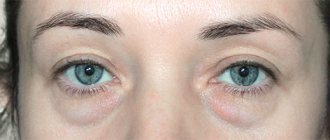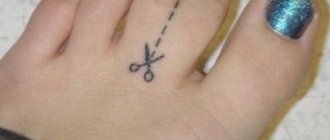Why do children develop an umbilical ring defect?
Medical systematization by type of origin umbilical hernias are defined as congenital
or
purchased
.
- A congenital hernia in a child is visually identified by a doctor immediately after birth - in the navel area there is a spherical (or cone-shaped) protrusion with a wide base, which passes into the umbilical cord.
- An acquired hernia can occur up to the age of three. Its visual identification is similar to that of a congenital hernia.
What is the cause of congenital umbilical hernia
A few days after the baby is born, the umbilical cord falls off. The umbilical ring consists of two parts. The lower part, where the umbilical arteries and urinary duct pass, contract well and form dense scar tissue. The umbilical vein runs in the upper part. Its walls are thin, do not have a muscular membrane, and subsequently contract poorly, which, with weak peritoneal fascia and an open umbilical vein, contributes to the formation of an umbilical hernia.
The contents of an umbilical hernia are usually intestinal loops. With light pressure, the hernial protrusion is freely retracted inward. With a very wide umbilical ring and a large hernia, intestinal peristalsis is sometimes visible outwardly, that is, contraction of the intestinal muscles and the movement of food through it, which is very frightening for many parents, but this does not cause inconvenience to the baby.
An important reason contributing to the occurrence of this pathology is the frequent increase in intra-abdominal pressure. It can be caused, for example, by frequent crying of a child, gas, constipation. The hole at the top of the umbilical ring may be wide and not cause distress to the baby. But in the case of a small defect with hard edges, the child may be worried. When a baby screams or cries, a hernial protrusion appears, which usually alarms parents.
Parents often associate the child’s increased anxiety with a strangulated umbilical hernia, but such developments of umbilical hernia pathologies in infants are extremely rare (in these cases, the hernial contents are fixed by adhesions to the inner wall of the skin of the anterior abdominal wall). As a rule, an umbilical hernia in children is always reducible. A strangulated umbilical hernia can be found more often in adult practice.
The main cause of umbilical hernias is a hereditary predisposition to weakness of the muscles of the anterior abdominal wall due to connective tissue dysplasia. This means that if the father or mother of the child themselves had this pathology in childhood, then the probability that their child will have a hernia is about 70%.
Misconception about umbilical hernia in newborns
There is a persistent misconception among parents that an umbilical hernia in a child often occurs due to an error by the obstetrician, who cut the umbilical cord incorrectly. Today, this superstition has no objective conditions because in obstetric practice the technique of applying an umbilical bracket , which leaves no chance for error even for a young obstetrician.
The direct cause of an umbilical hernia in newborns is an anatomical feature determined by the physiological weakness of the connective tissue in the navel area.
How to “earn” an acquired umbilical hernia
A preliminary diagnosis of “umbilical hernia” can be made during examination by the pediatrician observing the child. In the future, the doctor should refer the baby for a consultation with a surgeon to receive additional recommendations for monitoring and treating this condition.
The main causes of acquired hernia in a child:
- Due to the frequent and prolonged crying of the child, when the abdominal muscles are constantly tense, the internal organs are under pressure.
- Constipation and flatulence provoke periodic short-term but intense increases in intra-abdominal pressure and, as a result, the umbilical ring does not contract as effectively as it should, and, consequently, intestinal loops or the omentum can prolapse beyond the abdominal wall, forming a hernia.
- Early walking can also cause a hernia. During this period, the abdominal muscles receive a new unusual load and may not be strong enough.
Types of mesh for hernia
According to the degree of resorption, medical meshes for hernia treatment are:
- Absorbable . Over a certain period of time they dissolve in the human body. When using these endoprostheses, it is necessary to take into account that the time for complete wound healing and patient recovery is less than the time for resorption of the mesh endoprosthesis. There is a risk of relapse after complex operations.
- Non-absorbable . They do not dissolve in the human body at all. Such an endoprosthesis stays in the human body all his life and does not interfere with it in any way. Over time, they become overgrown with muscle tissue, as they have sufficient porosity. Most commonly used in medicine. The most reliable, with minimal risk of re-development of the hernia. They are produced, for example, by the Volot company.
- Partially absorbable . After muscle tissue builds up, it is partially resorbed in the body.
By form:
- Simple one-dimensional ones . They represent a grid that is in the same plane.
- Complex three-dimensional . A mesh consisting of 3 flaps located in different planes. The structure of the three-dimensional mesh is such that one flap is applied on the inside of the hernial orifice, and the other on the outside, and they are connected by a flap rolled into a cylinder, which fills the hole itself.
By coverage:
- Drug coated . Coated with a substance that prevents infection and promotes rapid wound healing.
- No drug coverage . No drug coverage.
By thickness:
- Lungs . Meshes with a thickness of 0.32-0.44 mm with a monofilament diameter of 0.09±0.01 mm. Intended for reconstructive surgical plastic surgery after removal of hernias of various locations, in cases where the tissues do not experience increased stress and/or their own tissues are in satisfactory condition, as well as for strengthening wounds.
- Classic . Meshes with a thickness of 0.45-0.70 mm with a monofilament diameter of 0.12±0.01 mm. Intended for reconstructive plastic surgery of the anterior abdominal wall after removal of a hernia, for damage to the diaphragm and chest wall, for soft tissue defects, as well as for strengthening traumatic and surgical wounds.
- Heavy . Meshes with a thickness of 0.65-0.99 mm with a monofilament diameter of 0.14±0.02 mm. Used to treat giant ventral hernias. They are used on areas of soft tissue that have greater mobility and are subject to increased stress.
- Superheavy . Meshes with a thickness of 0.65-0.99 mm with a monofilament diameter of 0.16±0.02 mm. Used in the most severe cases when the highest strength is required.
How not to be mistaken that your child has an umbilical hernia
The following signs are sufficient to accurately identify the disease:
- a protrusion in the navel area that decreases in size or disappears when lying down.
- abdominal pain that occurs with exercise and coughing.
- umbilical ring expansion
Diagnostic methods
Diagnostic methods for children are not numerous and are limited to the following list:
- examination by a pediatric surgeon;
- hernial protrusion;
Diseases with similar symptoms
There are not many diseases with similar symptoms; their list can be limited to the following:
- Hernia of the white line of the abdomen;
- Endometriosis of the navel;
- Oncological diseases and metastases of tumors of the stomach and duodenum (mainly in adults);
Rehabilitation after surgery
The recovery period can last 1-1.5 months. All this time you need to wear a special bandage.
- After the operation, the patient is under the supervision of a doctor. You can't get up during the first hours. The pain is relieved with an anesthetic drug, and an antibiotic is also prescribed.
- If abdominal surgery was performed, you cannot get up for two days.
- In the first week, regular dressings are performed.
- For two weeks, any physical activity, even light, is excluded. Even a cough can negatively affect the condition of the seam.
- You should start eating with liquid food, then steamed meat and fish, cereals, fruits and vegetables are introduced into the diet.
- After complete formation of the postoperative scar, exercise therapy is recommended to strengthen the back, abdomen, and thighs. Exercises are selected by the attending physician. Classes are held with a bandage on the stomach.
Subsequently, you should not lift weights or engage in intense sports. Nordic walking, walking, and light jogging are useful.
Prevention of acquired umbilical hernia
Prevention of the occurrence of an umbilical hernia is, first of all, the prevention of excessive straining of the child and bloating, which is usually caused by increased gas formation and constipation.
To prevent excessive intestinal bloating in a child and the development of constipation, the most favorable option for young children is breastfeeding, but the mother must follow a diet. We can advise mothers to temporarily exclude the following foods from their diet: whole milk, white cabbage, legumes, nuts, sweets, smoked meats, sausages. It is preferable to consume fermented milk products, bran, whole grain cereals, fresh vegetables and fruits. During breastfeeding, prunes and dried apricots (no more than 3-5 berries per day) are useful for preventing constipation.
If the baby is bottle-fed, in order to avoid constipation, bloating, colic, or an allergic reaction, the formula should be selected by a pediatrician. The doctor observing your baby may recommend medications: SAB-SIMPLEX, ESPUMIZAN, PLANTEX, BABY-CALME, etc.
To prevent constipation, which can occur in a baby due to improperly selected artificial nutrition, due to errors in the diet of a nursing mother, as well as in dysbacteriosis and other diseases of the gastrointestinal tract, in which excessive straining occurs, pediatricians recommend taking DUPHALAC among medications. , as well as the introduction of GLYCERIN SUPPLIES and microenemas - MICROLAX. Your pediatrician will tell you the dosage and specifics of administering these medications, since the prescription of drug therapy is purely individual and can only be done by the doctor monitoring your baby’s development.
Children with lactose intolerance (lactase deficiency) quite often have umbilical hernias. Lactase deficiency occurs in children who were born prematurely or at term, but remain functionally immature. In this condition, breast milk is partially or completely not digested, resulting in fermentation in the intestines and bloating. In addition, one of the forms of lactase deficiency may be a tendency to constipation. The most effective means of prevention for such children is a rational selection of feeding; during breastfeeding, additional administration of the lactase enzyme is often recommended.
At an early age, many children suffer from intestinal dysbiosis, that is, a violation of the intestinal microflora, which can occur against the background of lactase deficiency and other conditions. At the same time, constipation, as well as bloating, which accompanies dysbacteriosis, quite often provoke the occurrence of an umbilical hernia in babies. Treatment in this case should be aimed primarily at eliminating the symptoms of the underlying disease.
Complications
- If there is a hernia, it can be strangulated at any time. The organ located in the hernial sac becomes inflamed, blood circulation is disrupted, tissue necrosis and peritonitis develop. This complication is caused by lifting heavy objects, impaired bowel function, and physical activity (even small ones). Infringement can occur if the patient sneezes, coughs, or laughs. As a result, sharp, unbearable pain appears, the temperature of the hernial sac rises, and it becomes hard. Often accompanying symptoms are fever, vomiting, and headache. In this case, the patient needs urgent surgery.
- Inflammation of the internal organs located in the hernial sac. In this case, the person feels pain, the protrusion turns red, swells, and the overall body temperature rises. The patient's condition becomes worse.
- Intestinal obstruction. Occurs when feces clog the part of the intestine that is located in the hernial sac. Symptoms are similar to strangulation - nausea, constipation, vomiting, severe pain.
Umbilical hernia - surgery
Specialists perform operations to remove umbilical hernia in St. Petersburg. Affordable prices and professional surgeons.
How umbilical hernia in children is treated in Russia
Traditional treatment
Traditional methods of treating umbilical hernia in children have taken root well in the historical consciousness of the Russian population. From generation to generation, grandmothers and aunts of children with umbilical hernia syndrome tell their mothers encouraging stories about “miraculous” deliverance from hernias with the help of village healers. Among these inventive and resourceful healing methods, three methods stand out:
- Conspiracies with manual-tactile actions in the navel area;
- Applying a piece of an alloy of non-ferrous metals to the navel, in common parlance: “copper coins”;
- The use of a mixture of dried herbs in the form of tea leaves, the authorship of which is pretentiously attributed to hermits from the Christian-church pantheon.
Common sense ignores the empirical content of these “methods,” finding no reason to discuss the impossible. It is known that such social phenomena are the subject of study by specialists in legal law and social psychiatry.
Doctors explain the phenomenon of the existence of these wild superstitions in modern educated society by the ability of the child’s body to independently get rid of the symptoms of an umbilical hernia (so-called self-healing). In classical medicine, this fact is a scientifically based guarantee of parents’ hope for self-healing from a hernia, but for healers it is a reason to replace the true cause with their home-grown techniques.
A good recommendation for responsible parents is to definitely visit a pediatrician if you suspect the first signs of an acquired umbilical hernia. If your baby was diagnosed with an umbilical hernia in the maternity hospital, then in a few weeks make an appointment with a pediatric surgeon at your municipal medical institution (the referral is given by the pediatrician at the first visit).
So that you don’t miss anything from the specialist’s valuable recommendations, take your baby’s dad with you. Men cope better with new information and his additions to your memory will be useful. Strictly follow the doctor’s recommendations, remember that your diligence, together with parental love, is a reliable guarantee of the expected treatment result.
Today in our country, the system of medical patronage for children's health allows us to effectively treat many diseases in the early stages. And it is the pleasant duty of parents to take full advantage of this civilizational advantage over past generations.
Conservative treatment – or treatment of umbilical hernia without surgery
Up to 5 years of age, an umbilical hernia is not operated on, since it is possible to close the defect on its own. Many doctors believe that hernias that had the potential to heal themselves disappear in children under the age of 3, maximum 4 years; some authors talk about the possibility of closing PG before 6 years of age. But both experts agree that it is imperative to operate on umbilical hernias in children 6 years of age and older.
Hernia treatment methods
You can’t delay treating a hernia. If signs of a hernia are detected, you should immediately consult a surgeon.
The only way to treat a hernia is surgery. This type of operation is called hernioplasty.
.
Terms such as hernia repair
and
hernia removal
. But hernioplasty is a more correct name, since in most cases the hernia is not removed, but reduced.
Hernia removal – laparoscopic hernioplasty
The hernial contents are immersed through the hernial orifice back into the abdominal cavity, after which plastic surgery of the hernial orifice is performed. At this stage, the problem of preventing the re-formation of a hernia is solved. The area of the hernial orifice is strengthened either by the body’s own tissues or by implants (polymer meshes). Within a month, the mesh grows into body tissues. Such a frame reliably holds the organs in place. When using your own tissues, relapses may occur (in 25% of cases).
At Family Doctor, hernia removal (hernioplasty) is performed laparoscopically - through small punctures in the abdominal wall, which allows for faster healing and avoidance of conspicuous scars. Laparoscopic hernioplasty is performed in a surgical hospital, under local or spinal anesthesia. The use of polymer implants almost completely eliminates the possibility of re-formation of a hernia.
More information about the treatment method
Make an appointment Do not self-medicate. Contact our specialists who will correctly diagnose and prescribe treatment.
Rate how useful the material was
thank you for rating
Surgical treatment of pediatric umbilical hernia at the Laser Medicine Center
or why you shouldn’t be afraid to go to a pediatric surgeon
If the time allotted by nature to your baby’s health for self-healing is coming to an end, if all your conscientious efforts to help your child cope with this harmless pathology have not yielded results, then you should not hesitate and gather your courage and make a decision on surgical treatment of the hernia.
Please note that the uniqueness of a child for parents does not apply to his illness for a doctor. If a pediatric surgeon has several dozen operations to repair an umbilical hernia, then his professional experience is a sufficient guarantee of the success of the operation. When you are dealing with a doctor who has performed hundreds of similar operations, the child’s parents have an objective reason to be completely confident in the successful surgical treatment of their child.
Dear Parents.
You can get qualified help regarding the treatment of an umbilical hernia, as well as hernial protrusions of other origins, in the pediatric surgery department of the multidisciplinary clinic “Laser Medicine Center”.
We widely use modern effective treatment methods to achieve positive results. The department is equipped to the most modern standards, so your stay in the hospital will be as comfortable as possible.










